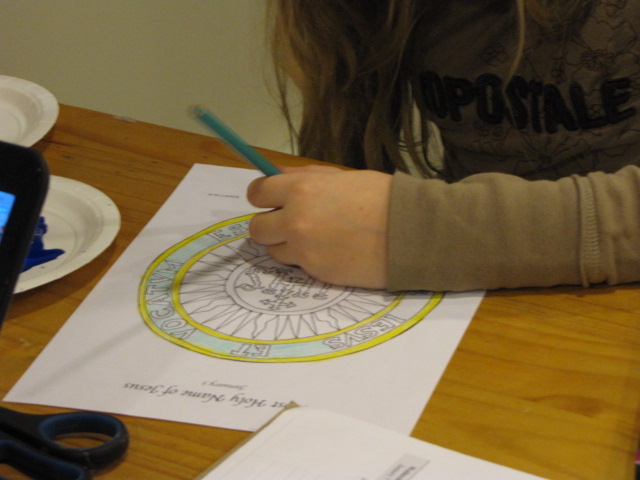January is the month dedicated to the Holy Name of Jesus. After being removed as a feast by Vatican II, this feast day was reinstituted by Pope John Paul II to take place on January 3rd.
In the 1962 Missal of Mass in the Extraordinary Form, the feast is on January 2nd.
I love this particular feast because it is such an opportunity to emphasize to children the extreme holiness and power in the name of our Lord Jesus Christ. This name should be used only with extreme reverence and never, ever as an expletive.
“Thou shalt not take the name of the Lord thy God in vain: for the Lord will not hold him guiltless that shall take the name of the Lord his God in vain.” Exodus 20:7 (Douay-Rheims Bible)
To use the Lord’s name in any way other than prayerfully is a mortal sin.
The Main January Feast
I usually begin our first day back from Christmas vacation with a simple craft and lesson to reiterate to the children the importance of this devotion. It’s a simple paper plate and paint craft.

Simply paint the rim of a cheap paper plate yellow and turn a small dessert sized plate upside down and paint it blue. Glue the blue plate on the yellow plate and put aside to dry (about ten minutes).
While it dries take advantage of the lovely coloring page provided by Charlotte Williams at her blog Waltzing Matilda. This link takes you to the free coloring page. Have the children color the symbol and cut it out.

When your lovely paper plate frame is dry, glue the cut out coloring page onto the blue plate. I glue a piece of yarn on the back and we hang them throughout the house as a reminder and call to prayer. “Blessed be the Holy Name of Jesus.” I have a more detailed version of this craft on my personal blog, Tales from the Bonny Blue House.

In her lovely book “The Little Oratory” Leila Lawler writes, “During prayer time teach your children to bow their heads slightly when the name of Jesus is mentioned. Little by little this practice will become second nature to them and a powerful witness to others.”
The January Feast Days and how we have celebrated in the past:
January 1 – Solemnity of Mary Mother of God
- Bring a statue of Mary to Mass to be blessed.
- Wear Blessed Mother blue.
- Pray a family rosary for the conversion of those steeped in sin.
- Have a blueberry dessert.
January 3 – Holy Name of Jesus
- Make a paper plate craft.
January 4 – Elizabeth Ann Seton (also the eleventh day of Christmas)
January 5 – Twelfth Night which is not a feast day at all, but a great deal of fun to celebrate. The book The 12 Days of Christmas: The Story Behind a Favorite Christmas Song explains the Christian symbolism behind the words of the song.
January 6 – Epiphany, the Feast of the Three Kings
- Make a king cake
January 10 – Solemnity of the Baptism of Our Lord
- If you have a newborn, it’s a great day for a baptism!
- There is a picture in Art 1 for Young Catholics that can be used as a coloring page.
- The scallop shell is a traditional symbol of Baptism; a scallop dinner would be a nice meal for the day.
- Filling a scallop shell (or any shell available from a craft store or from your last beach vacation) filled with some beeswax and a wick is a great craft idea.
January 21 – St. Agnes, patroness of young girls and chastity
- Agnes’ name means lamb, so lamb stew is a good dinner for this day.
- Since this feast occurs in winter, snowflakes have been called St. Agnes’ flowers. Any snowflake craft with a picture of the beautiful saint can be a nice way to commemorate the day.
- Pizzelle cookies are snowflake-like and readily available at the grocery store.
January 21 – Our Lady of Altagracia, patroness of the Dominican Republic
- This feast is all about gratitude.
- In the past we have enjoyed celebrating this feast day with the lessons from Catholic Mosaic, a lovely literature guide, and a coloring page from Finestrae Fidei.


Orange cupcakes and flowers add to the festivity.
January 28 – St. Thomas Aquinas
“Leaves without flowers, these are they who have words without works.”
Cut out some simple leaf shapes and write some sacrifices and chores for the children. Put them in a basket, and as they are accomplished over the week, string them along your mantle or bulletin board. Live St. Thomas’ words and be flowers with leaves.
Pick One or Two!
I hope these little ideas help you to bring the liturgy alive in your homeschool. Please just pick one or two and don’t overwhelm yourself.
You are in this homeschool gig for the long haul and there will be many years to establish traditions and to get to everything.
If you are in a season of life that is full of toddlers and newborns, bless you and leave the crafty stuff aside for another year.
Read a picture book, say a prayer and wait until the little ones grow a bit. It will all keep.

 Seton Magazine Catholic Homeschool Articles, Advice & Resources
Seton Magazine Catholic Homeschool Articles, Advice & Resources
